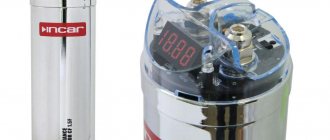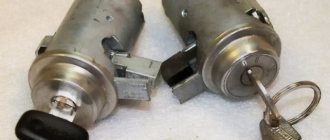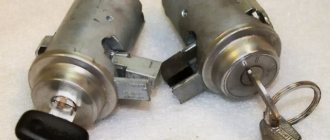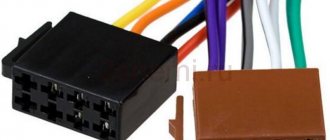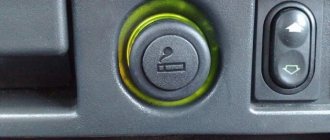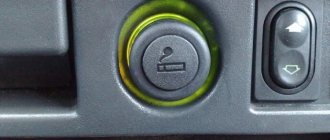Why do you need a capacitor for a subwoofer?
An electrical capacitor is a two-pole device capable of accumulating, storing and releasing electrical charge. Structurally, it consists of two plates (plates) separated by a dielectric. The most important characteristic of a capacitor is its capacitance, which reflects the amount of energy that it can accumulate. The unit of measurement for capacitance is the farad. Of all types of capacitors, electrolytic capacitors have the highest capacity, as well as their further improved relatives - ionistors.
To understand why a capacitor is needed, let’s figure out what happens in the car’s electrical network when low-frequency car acoustics with a power of 1 kW or more are connected to it. A simple calculation shows that the current consumed by such devices reaches 100 amperes or more. The load is uneven, the maximums are reached at the moments of bass hits. The voltage drop when the car audio passes through the peak of the bass volume is caused by two factors:
- The presence of internal resistance of the battery, limiting its ability to quickly release current;
- The influence of the resistance of the connecting wires, causing a voltage drop.
The battery and capacitor are functionally similar. Both devices are capable of storing electrical energy and subsequently releasing it to the load. The capacitor does this much faster and more readily than the battery. This property underlies the idea of its application.
How to choose a capacitor
The required capacitor capacity depends on the power of the subwoofer. In order not to go into complex calculations, you can use a simple rule of thumb: for 1 kW of power, a capacitance of 1 farad is required. Exceeding this ratio is only beneficial. Therefore, the most common high-capacity capacitor on sale, 1 farad, can also be used for subwoofers with a power of less than 1 kW. The operating voltage of the capacitor must be at least 14 - 18 volts. Some models are equipped with a digital voltmeter indicator. This creates additional ease of use, and electronics that control the charge of the capacitor make this procedure easier.
Parameters for selecting a capacitor
Let's consider the main criteria that affect the quality of operation of the capacitor.
- Power. This is the first and main parameter to choose. It is necessary to buy a device whose power will be equal to the number of kilowatts of the system. That is, if you have a system with a power of five kilowatts, then the device must have a capacity of at least five farads. Experts advise taking devices with a capacity slightly larger than the power of the system.
- Connectors. Their operating voltage should reach twenty-four volts. To minimize current resistance, the connectors of virtually all devices are gold-plated.
- Equipment. Check that the package includes all the elements required to install the device. The capacitor from the amplifier should be installed at a distance of no more than fifty centimeters.
- Charging speed and charge release. These characteristics depend on how high-quality the device you purchase. Refrain from buying counterfeits and homemade capacitors.
- Charge control function. This function is present in more expensive models, but devices of this type will protect the wiring of your car. If the device you purchased does not have this function, then it must be recharged before installation.
- Digital voltmeter and light indication. Using a voltmeter you can monitor the voltage of the device. Light indicators show the charge level of the device.
In order for your purchase to please you with high-quality sound, you need to buy products in certified stores that specialize in car acoustics products.
How to connect a capacitor to a subwoofer
Installing a capacitor is not a complex procedure, but when performing it you need to be careful and follow some rules:
- To avoid a noticeable voltage drop, the wires connecting the capacitor and the amplifier should not be longer than 50 cm. For the same reason, the cross-section of the wires must be chosen large enough;
- Polarity must be observed. The positive wire from the battery is connected to the positive power terminal of the subwoofer amplifier and to the capacitor terminal marked with a “+” sign. The capacitor terminal marked “-” is connected to the car body and to the negative terminal of the amplifier power supply. If the amplifier was previously connected to ground, the negative terminal of the capacitor can be clamped with the same nut, while maintaining the length of the wires from the capacitor to the amplifier within the specified limits of 50 cm;
- When connecting a capacitor to an amplifier, it is better to use standard clamps to connect wires to its terminals. If they are not provided, you can use soldering. Twisted connections should be avoided as significant current flows through the capacitor.
Figure 1 illustrates the connection of a capacitor to a subwoofer.
How to charge a capacitor for a subwoofer
To connect to the car's electrical network, an already charged car capacitor should be used. The need to perform this action is explained by the properties of the capacitor, which were mentioned above. The capacitor charges as quickly as it discharges. Therefore, at the moment the discharged capacitor is turned on, the current load will be too high.
If the purchased subwoofer capacitor is equipped with electronics that control the charging current, you don’t have to worry; feel free to connect it to the power circuits. Otherwise, the capacitor should be charged before connection, limiting the current. It is convenient to use an ordinary car light bulb for this, turning it on against the power supply circuit. Figure 2 shows how to properly charge large capacitors.
If after reading the article you still have questions about connection, we recommend that you read the article “How to connect an amplifier in a car.”
What is a car capacitor and why is it needed?
Today, a car capacitor is usually understood as an electrolytic capacitor connected to a car audio amplifier (or directly to a radio) in parallel with the supply wires. But why is it needed?
Capacitors are often used to protect against network interference.
1. Filtering of power supply interference. Capacitors have been used for a long time as the simplest, but at the same time, quite effective filter of power supply interference - they have probably been noticed by everyone who has happened to look inside electronic devices. The capacitor is charged by the supply voltage and, in the event of a sharp drop in voltage, compensates for the drawdown, returning the accumulated charge to the network. Usually, high-quality car amplifiers have their own protection against voltage sags, but if you hear extraneous sounds from the speakers when you turn on auto electrical components (fan, wipers, headlights, etc.), a capacitor can help. And one more thing - regardless of where the capacitor is installed in the car network, it will maintain the voltage of the entire network, and not just the amplifier. Therefore, if your headlights flicker when the audio system is running, then after installing the capacitor they will stop flickering (they will burn at full intensity). Another thing is that strong (until the headlights flicker) drawdowns during operation of the audio system clearly signal a lack of power from the generator and battery. Installing a capacitor will not solve this problem - it is not a source, but a consumer of energy, and in the event of a power shortage, it will likely worsen the problem.
2. Supports power supply to the radio during peak loads, for example, when playing bass. There are two options here:
2.1. There is not enough power going to the audio system. The reasons may be different: a dead battery, a weak generator, power wires of insufficient thickness, etc.
What does it look like in theory?
In this case, when installing a capacitor (close to the amplifier), theoretically, it is possible to obtain a certain increase in sound volume without distortion - provided that the excessive loads are short-term (no more than a fraction of a second) and are interspersed with periods of reduced load of no less duration (so that the capacitor can restore charge).
And as most often happens in practice.
But real music cannot meet such requirements - the bass in compositions rarely sounds for less than a few seconds. Therefore, there will be practically no noticeable effect - it can hardly be called an improvement in sound quality if the speaker starts wheezing a third of a second later than usual.
2.2. There is enough power, but the battery does not have time to “give” the required current. As you know, when a consumer appears, the battery discharge current does not set instantly; and the installation time depends on the characteristics of the battery - primarily on the internal resistance (more precisely, on the reactive component of the internal resistance). And if the internal resistance of the battery is high, then when the load sharply increases, it will provide the required current with some delay, small, but sound distortion at this moment can already be noticeable.
Connection diagram of a capacitor to the amplifier power circuit.
Indeed, in this case, installing a capacitor may be an acceptable alternative to replacing the battery. This will not completely solve the problem, but it can smooth out the bass fronts, for example.
This is not a capacitor.
Recently, “capacitors” have appeared on the shelves of car dealerships, characterized by a huge (up to hundreds and even thousands of Farads) capacity, but at the same time having a modest size and a very attractive price. These are not capacitors, these are ionistors. There is little point in connecting them to an amplifier - yes, they have the declared capacitance, but ionistors differ from capacitors in their high internal resistance (ESR), low maximum discharge current and low rate of installation of the supplied current. There are ionistors with low ESR, similar in characteristics to capacitors, but they are much more expensive.
Additional benefits of installing capacitors in cars
In addition to solving problems with the operation of the subwoofer, a capacitor connected to the car network has a positive effect on the operating mode of electrical equipment as a whole. This manifests itself as follows:
- The capacitor is a good filter for high-frequency components of the mains voltage that arise when switching loads and operating some electronic devices; its functions have a beneficial effect on the operation of all vehicle systems;
- The use of a capacitor makes it possible to smooth out voltage surges that occur when consumers on the on-board network are turned on and off, which allows the generator to operate in a more even mode;
- When the car is started by the starter, the capacitor, of course, takes an additional part in it, giving its charge to the on-board network. This is especially true in winter, when the battery’s ability to deliver current decreases, but the properties of the capacitor do not change.
The capacitor is installed, and you notice that your subwoofer is starting to play more interestingly. But if you try a little, you can make it play even better, we suggest you read the article “How to set up a subwoofer.”
What and why do you need a capacitor in a car?
Capacitors are used to accumulate and also to store electric current and create, if necessary, greater tension in the electrical system.
Capacitors are needed to store and also store electric current.
As a rule, capacitors are used for filtering and suppressing various interferences. The role of such radio-electronic elements in modern life cannot be underestimated, which happens often, since their purpose is not completely clear to everyone.
What is a capacitor
A capacitor for a subwoofer is designed to accumulate (condense) energy and release it to the consumer at the right time. The storage device has low internal resistance and therefore releases the accumulated energy quite quickly. The peak of recoil occurs at the first moment, and then the charge drops sharply, as does the outgoing speed.
To be precise, the capacitor (storage) is used not for the subwoofer, but for the amplifier that controls this subwoofer.
It is important to understand that a capacitor is a consumer and does not generate energy itself.
Do you need a capacitor for a subwoofer?
Smoothing out voltage dips during peak loads is what a subwoofer capacitor is for. It would seem like a useful thing, but only at first glance.
The fact is that by the word “capacitor” most people mean an ionistor. The definition of the word can be googled, but simply put, it is something between a capacitor and a chemical current source.
Typical "capacitor"
Unfortunately, in the form in which audio manufacturers offer us, ionistors have a number of disadvantages:
- big losses
- high resistance compared to a capacitor
- low output speed compared to a capacitor
The advantages include low cost, again in comparison with a capacitor of the same capacity.
A capacitor is not needed in the system; if it corrects some problems, it means that the power supply is not organized correctly!
In connection with the last statement, let's look at several situations.
An example of bad wiring
If you have a very powerful sub link, a loud system and you want to rock the area or even participate in sound pressure competitions, then such drives will not help you, in this situation you need to install real high-quality products, the cost of which starts from $300 . And if you are at this level, then it will be much more efficient to spend money on laying wiring of the maximum cross-section, replacing an acid battery with an AGM, or installing additional batteries.
Additional food
Application of capacitor
It turns out that almost always using a capacitor does not make sense. But then what are they even needed for? In addition, they can be found in high-level systems!
Brax IPC 27000r.
The fact is that a real high-quality capacitor well suppresses high-frequency and low-frequency interference, voltage changes when fans are turned on, electrical noise, and the like, so in high-level projects (usually focused on sound quality) with a large amount of equipment, the use of these devices is justified, and sometimes necessary.
PS: Be careful about custom articles and their thoughtless copies about the benefits and necessity of capacitors in an everyday system.
Condenser installation
When installing a capacitor, it is recommended to connect it in parallel with the power supply of the amplifier (see How to connect an amplifier to a car radio: you are your own master). It must be placed as close as possible to the power amplifier, at least no further than 60 cm. If you put a capacitor in place of the ionistor, the result will be much more effective. Everything is done like this:
- The car generator is repaired or a new one is installed;
- A cable is laid from it to ground and plus;
- A new battery is installed;
- All terminals are changed or thoroughly cleaned;
- A good quality power copper cable with a sufficient cross-section is laid;
Capacitor circuit
- We connect the amplifier, do not forget the fuse.
Advice. Until we check all the terminals and make sure that there is 14 volts, we do not connect the capacitor.
- After everything has been checked, you can connect the capacitor. Measurements at the terminals will show the same results, but you shouldn’t be surprised. If the circuit is “live” and there is enough power, then the capacitor has nothing to turn on and it seems to be waiting in the wings.
Note. Another misconception is the fact that supposedly a capacitor is needed in systems where high volume is required or in SPI El competitions. In normal cases, a capacitor will successfully replace an ionistor.
You can prove the need for a capacitor in conventional car speaker systems based on the following:
- Measuring the capacitor can last a long time, and this will “wake up” even the most acidic battery and thus be able to give up its full potential;
- Among the so-called espi ale fraternity, the use of gel batteries, capable of “shooting” hundreds of amps with amazing speed, is more common. No matter how much we praise the capacitor, at such a speed it will “feel” clearly out of work;
- Again, regarding the espi el, the capacitor is out of place, since it is an energy consumer, which is clearly evil for the espi el.
In a word, the ESPI EL certainly does not use any capacitor or other storage device.
Operating principle of a capacitor
For modern subwoofers, short-term peaks are enough to start drawing more current. As a result, it cannot fully provide energy to the battery. Even the thick wires that feed the amplifier do not have such resistance that will cause a decrease in voltage at the moments of the pulses.
Connecting a subwoofer to an amplifier and capacitor
As a result, the functionality of the amplifier is reduced. To eliminate such phenomena, it is necessary to install a drive in the car. It is an electrolytic device with a large capacity. Connected in parallel with respect to the power circuits on the amplifiers. The resistance of the equipment is very low, and the current is transferred to the amplifier at lightning speed. Thanks to this, the occurrence of subwoofer malfunctions is excluded. Just as quickly, the capacitor is recharged again and “gives” a portion of the current back.
So, what is a subwoofer capacitor for? In simple words, we can say this: the device accumulates and quickly transmits electricity. In technology, this function is used to improve the sound of a car radio.
Capacitor
There is an opinion that the current storage prolongs the life of the battery or facilitates its operation. And some car owners install devices based on this consideration. But this is a proven myth! The storage device does not produce energy. It only accumulates electricity and delivers it to the consumer.
The best capacitors
Which capacitor is better for acoustics?
Today, there are a lot of capacitors, like any other car audio products, on the market. Some amplifier manufacturers even provide terminals in advance for connecting a capacitor.
Note. Such amplifiers include the Audison Vesis HV Venti, which was even recognized as the best acoustic amplifier of last year.
Focal
Another well-known manufacturer of amplifiers and high-quality audio equipment, but from France, Focal, uses a different solution in its models: there is a place for capacitors after the amplifier's power supply. This is where, according to experts, the efficiency of using additional storage devices is many times higher.
Which capacitor is better for acoustics?
Note. The disadvantage of such a capacitor is that it is only suitable for amplifiers of the Focal brand.
The features of this capacitor are as follows:
- Significantly improves sound performance;
- This is not even one capacitor, but several. They are collected into a single module.
Note. The number of capacitors corresponds to the number of amplifier power supplies.
- The connection is made using the supplied cable through a special connector;
- In difficult operating conditions, the stability of the amplifier is increased due to High-Cap technology.
When installing a capacitor with your own hands, it will be useful to watch a thematic video review. Equally important are high-quality photos - materials, diagrams, instructions and drawings. The price of capacitors varies, but the best of them all is not cheap.
What types of automotive capacitors are there?
Today, many different capacitors for cars are already produced. From the simplest and cheapest models, to elite and expensive ones, with a large capacity of 20F. Such capacious installations are used in powerful equipment that has a distributor and has the ability to connect more than two amplifiers at the same time.
Automotive capacitor
The choice of device depends on several factors. Basically, you need to consider the power of the car's battery. Never buy equipment if it looks questionable. Capacitors have the “property” of exploding. And even the slightest violation of the integrity of the structure can lead to an explosion.
When inspecting the device in a store, you need to pay attention to the presence of protection on the terminals. They protect the system from accidental short circuits. It is also important to study the ease of connection and installation.
Automotive capacitor
Capacitor in a vehicle's electric motor
Capacitors for electric motors of cars can be working or starting. Working capacitors ensure correct operation of the electric motor, and starting capacitors are used to improve the starting torque.
Tasks of starting automotive capacitors for the engine
- economical operation of electrical equipment;
- increased torque;
- ability to withstand high loads;
- ensuring optimal service life of the electric motor.
Unlike running capacitors, starting capacitors are switched on when the engine is started. Running capacitors ensure the correct functioning of the engine directly during operation.
What equipment capacity is needed?
There is no exact formula here. Many follow this rule: 1 kW. from the power of the amplifier must correspond to 1 F of the capacitor capacitance. This is normal and most users purchase the design precisely for this reason. For example, if your car has an audio system with a power of 2 kW, then you need to purchase a drive with a capacity of 2 Farads. But experts recommend choosing a device with a large supply of capacity.
Some models have built-in voltmeters. They control the system voltage level. Devices with voltmeters are more expensive.
How to install a drive in a car
Installation is usually carried out close to the amplifier. This prevents the amplitude of the electricity from decreasing. Since the connecting wires always produce resistance due to the low resistance of the capacitor. It is important to know that a distance of no more than 60 cm should be maintained from the amplifier to the capacitor. The smaller this gap, the better the installation.
Connecting a subwoofer
Some people mount the structure directly on the amplifier. It is convenient, practical and neat looking. Doesn't take up much space in the cabin. But there are other ways to arrange the system. For example, many car enthusiasts have gotten used to placing the amplifier in the luggage compartment, on the side of the wall. And the capacitor is on the opposite wall. It looks nice, but from a technical point of view it is not practical, since the distance is too large.
An important point: when installing a current storage device, it is not allowed to connect it uncharged to the positive and negative power wires. Because with such contact, the device will be “powered” by current from the battery, and this leads to burning of the fuse.
To avoid such troubles, manufacturers began to attach special circuits to their products, according to which the capacitors are charged gradually. If such a circuit is not available, then you need to charge the equipment in advance through a 12-volt light bulb. If the light goes out during installation of the device, it means it is sufficiently charged.
Capacitor for a subwoofer in a car
Connection recommendations
- The system can be connected to circuits of any power. Even in cases where one amplifier built into the head unit is working. But when installing a capacitor in an audio system equipped with an external amplifier, the first step is to start with the minimum system power (from 250 to 300 W).
- Such a device does not have to be connected only to a sound system that has a special battery. It’s just that such a “sonic” battery can quickly supply current and just as quickly unload the car’s network.
- If you are going to connect the device yourself, it is better to have protective circuits. Also, you should have on hand devices that monitor the state of the on-board network.
Be sure to follow the diagram when connecting elements. It has visual drawings showing the location of electrical circuits. All important information is also present on the diagram.
Many drivers of cars of both expensive brands and budget models install good acoustic systems in the interior. To achieve high-quality sound at low frequencies, you need to add an electrolytic capacitor for the subwoofer to the audio system amplifier.
general information
The best capacitors for acoustics
So why do you need a capacitor? As you know, the price for it is not small and not all motorists, even lovers of good sound, want to cut their budget once again. On the other hand, every music lover sooner or later acquires a powerful speaker system or brings it to perfection. This is very good, but the more powerful the system, the more energy you give it.
A capacitor in acoustics (see) is a component that serves as an additional power source for an amplifier. This element is very important and
Read more: Changing the oil in an automatic transmission with your own hands, video instructions
So, the capacitor is able to solve the problem with dips, since it is a high-capacity electrolytic device, the connection of which occurs in parallel with the power supply circuit of the amplifier. The capacitor has practically no resistance, or rather, it is so small that the current is given to the amplifier instantly, thereby eliminating the occurrence of dips. Then, with the same speed, the capacitor is charged again and is ready to give out the next portion of beneficial current for the amplifier.
How to choose a capacitor
When choosing a capacitor for a car electrical system, you should take into account 2 important parameters: capacitance and equivalent series resistance (ESR, Equivalent Serial Resistance), which determines the speed of release of the accumulated charge. The capacity required is large, compared to ordinary electrolytic storage devices (in jargon - “electrolytes”).
For modern automotive devices, drives are offered with capacities ranging from tenths of a farad to several tens of farads, with internal resistance from several hundredths to thousandths of an ohm. The lower the internal resistance, the more efficiently the electrolyte releases its charge.
The higher the power of the audio amplifier, the greater the electrolyte capacity required. It is estimated as follows: per 1 kW of amplifier power, a minimum of 1 farad is required. If the capacity is larger, it will not harm the system. You should buy drives of proven models from reliable suppliers.
Popular brands range in price from $40 to $400 or more.
Expensive models are equipped with a protection system against overvoltage and switching on in the wrong polarity (i.e. when plus is supplied to minus, and minus to plus).
Typical characteristics of drives from one trusted manufacturer for cars with a 12 V power supply are shown in Table 1.
| Models type 1, 2 and 3 | |
| Nominal capacity, farad | 1/1,5/2 |
| Permissible error of capacitance value, % | + / — 5 |
| Maximum operating voltage, V | 16 |
| Peak value of pulse voltage, V | 24 |
| Equivalent series resistance (ESR), Ohm | 0016 |
| Operating temperature, °C | -10 to +105 |
| Dimensions (diameter*height), mm | 76*245 |
| Weight, kg | 1,5 |
Installing a dubious inexpensive capacitor in the system will be useless due to the fact that its actual capacity, as established by practice and tests by independent experts, is 10 or more times less than the declared one, and the ESR value does not meet the standards. Since the electrolyte housing is sealed and cannot be opened by the buyer, unscrupulous manufacturers take advantage of this and save on materials for the linings; they put broken bricks and pieces of cement on the bottom for weight, and fill the remaining space with resin.
There are so many similar products on the market for storage devices for car audio systems that a myth has formed among car enthusiasts about the uselessness of installing a capacitor in a car.
